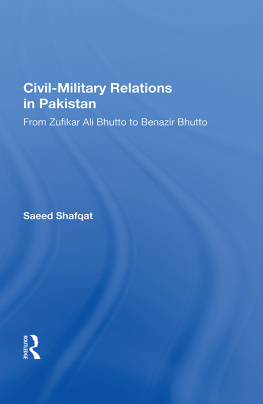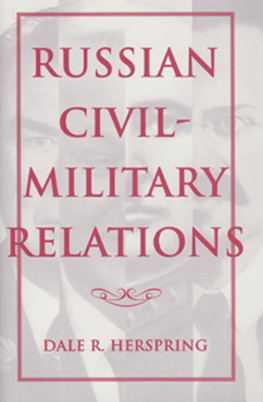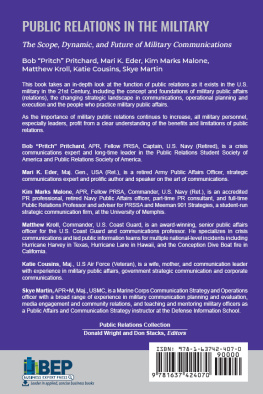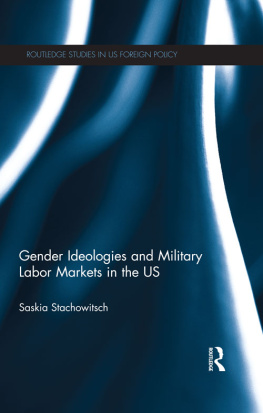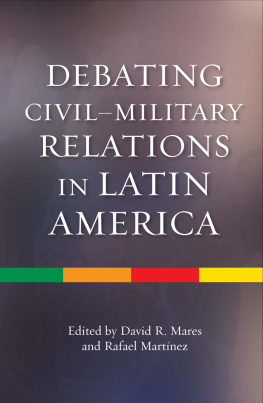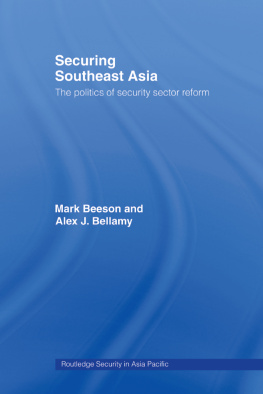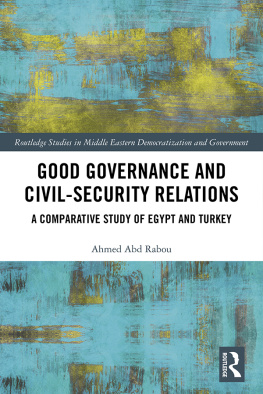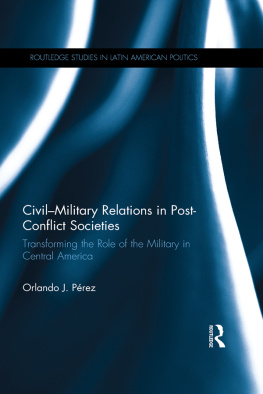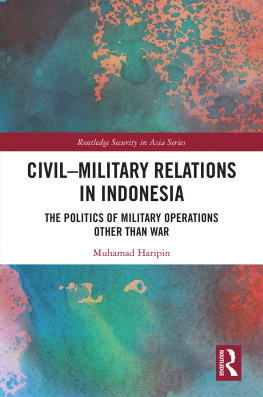INTEGRATION VS. AUTONOMY: CIVIL-MILITARY RELATIONS ON THE KOLA PENINSULA
Integration vs. Autonomy
Civil-Military Relations on the Kola Peninsula
Geir Hnneland and Anne-Kristin Jrgensen
The Fridtjof Nansen Institute
First published 1999 by Ashgate Publishing
Reissued 2018 by Routledge
2 Park Square, Milton Park, Abingdon, Oxon, OX14 4RN
711 Third Avenue, New York, NY 10017, USA
Routledge is an imprint of the Taylor & Francis Group, an informa business
Copyright Geir Hnneland and Anne-Kristin Jrgensen 1999
All rights reserved. No part of this book may be reprinted or reproduced or utilised in any form or by any electronic, mechanical, or other means, now known or hereafter invented, including photocopying and recording, or in any information storage or retrieval system, without permission in writing from the publishers.
Notice:
Product or corporate names may be trademarks or registered trademarks, and are used only for identification and explanation without intent to infringe.
Publisher's Note
The publisher has gone to great lengths to ensure the quality of this reprint but points out that some imperfections in the original copies may be apparent.
Disclaimer
The publisher has made every effort to trace copyright holders and welcomes correspondence from those they have been unable to contact.
A Library of Congress record exists under LC control number: 99073625
ISBN 13: 978-1-138-31423-8 (hbk)
ISBN 13: 978-0-429-45715-9 (ebk)
In 1995, our former colleague Rune Castberg received funding from the Norwegian Ministry of Defence for the current project, formally named Changed relations between the military and civilian sectors of Northwestern Russia. He never got the time to start it before leaving for a new position at the Norwegian Embassy in Moscow early in 1997. Hence, after a slight reformulation of the research topic, the present authors embarked on the project in the winter of 1996-97.
As will be further elaborated on in ), and that we ourselves also have experienced several unpleasant or suspicious episodes (one of them is mentioned in note 6 in the introductory chapter) during our visits to Murmansk, made us decide to keep a low profile with Russian authorities during the last part of the project period.
During our work with the project, we have received invaluable help from a range of persons. Several of our present and previous colleagues here at the Fridtjof Nansen Institute (FNI) were involved as draft commentators in the early phase of the project. In particular, we want to thank Rune Castberg and Arild Moe for active participation in the ), and for general language assistance. Finally, thanks to Trine Giasver and Yngvar Gotaas for putting up with us at home during the last few months.
Outside the house, we have received help from Julian Cooper at the University of Birmingham, Yevgeniy Kogan at FOA (the Swedish Defence Research Establishment), Rolf-Inge Vogt Andresen at FFI (the Norwegian Defence Research Establishment), Helge Blakkisrud at NUPI (the Norwegian Institute of International Affairs), Yngvar Aagaard at the Barents Conversion Centre, and Thomas Nilsen and Nils Bhmer at the Bellona Foundation, We would like to extend our thanks to them and to the following "official" figures in Russia: Grigoriy Mil'dov, leader of the Department for the Problems of the Military Garrisons and the Social Protection of Military Servicemen at the Murmansk regional administration, Anatoliy Sarenko, Chairman of the Election Commission of Murmansk oblast' (and his helpful secretary, whose name we do not know), Viktor Kotenko, Chairman of the Murmansk Regional Committee of State Statistics, Nikolay Timofin and Nikolay Ostapchuk, leaders of the Murmansk department of the Russian Union for Redundant Officers, Valentina Fomina and Nadezhda Tekina at the Committee of Soldiers' Mothers in Murmansk, journalist Viktor Litovkhin at Izvestiya, and retired admiral and author Nikolay Mormul'. A number of present and former officers, as well as members of their families, have provided useful information in more informal interviews.
). Last but not least, thanks to Ashgate Publishing Ltd. for publishing the book.
Finally, we can only express hope that we have done justice to the topic under investigation. Since our work in the field became known, we have experienced keen interest from both the media and research circles. We hope that expectations to the book have not been raised to unduly high levels, and would once again remind readers of the practical difficulties in shedding light on the issue of civil-military relations on the Kola Peninsula. It should also be noted that the two of us have not been occupied solely with this project for the last two years; all in all, we have had 15 man-months at our common disposal. Most of all, however, we hope that with this book and the other publications from the project, we can contribute to illuminating the extremely grave problems facing both the military and civilian sector in the region, and the fate of its inhabitants. At the same time, we hope that our account is more nuanced than the typical "atrocity stories" so common at least in the Norwegian media when reporting from the Kola Peninsula. Paradoxically, frequent visits to Murmansk to study its legacy from the Cold War have gradually opened up our eyes to the beauty of this Arctic city so often described as hideous by outsiders.
Lysaker, April 1999
Geir Hnneland
Anne-Kristin Jrgensen
Part I
Introduction
The research project leading up to the current book was initiated by a general interest in, as well as competence on, the geographical area under investigation rather than on the particular functional field at issue. It grew out of several years' research on political and economic conditions in Northwestern Russia - and in Murmansk oblast ', or the Kola Peninsula, in particular - whereas both the initiator of the project (see
As will be further discussed in Unfamiliar as our working methods are for parts of the Northwest Russian establishment, we have occasionally been mistaken for journalists and probably also been suspected by some of being spies. The methodological restrictions imposed by these circumstances are further discussed below. First, however, a brief background description of the topic of study is appropriate.

The location of Murmansk oblast'
Background
The Kola Peninsula is frequently referred to as one of the most militarised areas in the world. The Northern Fleet, which is the largest and strategically most important of the four fleets of the Russian Navy, has its main base and administrative centre in the city of Severomorsk in the Kola Fjord. More than half of Russia's strategic nuclear submarines are stationed at the various Kola naval bases. About one third of the approximately one million inhabitants of Murmansk oblast' are probably directly dependent on the military sector, and at least half of those included in this group are civilians. Traditionally, there has been a sharp division between the civilian and military sectors in the area, as in every part of the former Soviet Union. This was partly a result of the Soviet principle of keeping the military sphere as separate from the civilian one as possible, partly of the vertical command system, in which horizontal ties between different sectors of the economy were generally weak. In Soviet times, civilian regional authorities did not and could not interfere in the military sphere. Using the terms chosen as the conceptual basis for the current discussion, civil-military relations on the Kola Peninsula were characterised by a situation in which the military's autonomy was virtually uncurtailed.


